Study on Spraying Construction Method of a Non-Water Reacting Polymer Layer in the Tunnel
Abstract
:1. Introduction
2. Materials and Methods
2.1. Physical Model
2.2. Spraying System and Work Principle
2.3. Test Procedure and Process
3. Results and Discussion
3.1. Material Ratio
3.2. Material Temperature
3.3. Environmental Factors
- (1)
- Environment and tunnel base temperature
- (2)
- Humidity of tunnel base
- (3)
- Wind speed
3.4. Spraying Pressure
3.5. Spray Gun Operational Parameters
- (1)
- Spray gun speed
- (2)
- Spraying distance
- (3)
- Spraying angle
3.6. Recommended Spraying Parameters for Polymer Damping Layer
4. Case Study
4.1. Project Overview
4.2. In-Situ Application and Results
5. Conclusions
- Based on the influence of environmental factors on the polymer damping spraying layer and the analysis of construction site conditions, it is found that heat affected the overall spraying effect, and the main ways of heat loss included heat exchange due to low ambient temperature, heat carried away by airflow (wind) and heat absorbed by the sprayed base wall. The above factors should be comprehensively considered in spray design and construction to minimize heat loss and ensure the spraying quality of the polymer damping layer.
- At significantly lower/higher initial material temperature or higher relative humidity, the uniformity of the damping layer was affected, and thus the adhesive strength between the polymer damping layer and the base was reduced.
- It is necessary to maintain the same proportion of Components A/B of the polymer materials and reasonably control the spray gun pressure and spray gun motion parameters (i.e., distance, speed and angle), in order to achieve a more uniform polymer damping layer.
- Improve polymer materials to enhance the shock absorption performance of materials.
- Further develop automatic spraying equipment to realize automatic spraying construction with the dynamic adjustment of spray parameters, based on the obtained parameter table.
Author Contributions
Funding
Institutional Review Board Statement
Informed Consent Statement
Data Availability Statement
Acknowledgments
Conflicts of Interest
References
- Konagai, K.; Takatsu, S.; Kanai, T.; Fujita, T.; Ikeda, T.; Johansson, J. Kizawa tunnel cracked on 23 October 2004 Mid-Niigata earthquake: An example of earthquake-induced damage to tunnels in active-folding zones. Soil Dyn. Earthq. Eng. 2009, 29, 394–403. [Google Scholar] [CrossRef]
- Zhao, K.; Chen, W.; Yang, D.; Zhao, W.; Wang, S.; Song, W. Mechanical tests and engineering applicability of fibre plastic concrete used in tunnel design in active fault zones. Tunn. Undergr. Space Technol. 2019, 88, 200–208. [Google Scholar] [CrossRef]
- Chen, Z.; Liang, S.; Shen, H.; He, C. Dynamic centrifuge tests on effects of isolation layer and cross-section dimensions on shield tunnels. Soil Dyn. Earthq. Eng. 2018, 109, 173–187. [Google Scholar] [CrossRef]
- Li, C.; Chen, W.; Zhao, W.; Suzuki, T.; Shishikura, Y. A Study on Seismic Isolation of Shield Tunnel Using Quasi-Static Finite Element Method. Shock Vib. 2019, 2019, 6209409. [Google Scholar] [CrossRef]
- Ma, S.; Chen, W.; Zhao, W. Mechanical properties and associated seismic isolation effects of foamed concrete layer in rock tunnel. J. Rock Mech. Geotech. Eng. 2018, 11, 159–171. [Google Scholar] [CrossRef]
- An, D.; Chen, Z.; Meng, L.; Cui, G. Application of fiber-reinforced concrete lining for fault-crossing tunnels in meizoseismal area to improving seismic performance. Adv. Mech. Eng. 2020, 12, 1687814020944023. [Google Scholar] [CrossRef]
- Su, L.; Liu, H.; Yao, G.; Zhang, J. Experimental study on the closed-cell aluminum foam shock absorption layer of a high-speed railway tunnel. Soil Dyn. Earthq. Eng. 2019, 119, 331–345. [Google Scholar] [CrossRef]
- Lin, Z.; Guo, C.; Cao, D.; Ni, P.; Wang, F. An experimental study on the cutting failure of polymer grouting. Constr. Build. Mater. 2020, 258, 119582. [Google Scholar] [CrossRef]
- Guo, C.; Hu, D.; Wang, F. Diffusion Behavior of Polymer Grouting Materials in Sand and Gravel. Soil Mech. Found. Eng. 2021, 57, 440–444. [Google Scholar] [CrossRef]
- Wang, Y.; Wan, Y.; Liu, Q.; Guo, C.; Shi, M. Interfacial shear properties of non-water reacted polymer and geomaterials. J. Build. Mater. 2021, 24, 115–120. (In Chinese) [Google Scholar]
- Wang, C.; Guo, C.; Du, X.; Shi, M.; Liu, Q.; Xia, Y. Reinforcement of silty soil with permeable polyurethane by penetration injection. Constr. Build. Mater. 2021, 310, 124829. [Google Scholar] [CrossRef]
- Li, X.; Wan, J.; Zheng, D.; Fang, H.; Wang, F.; Hu, S. Compressive mechanical properties of self-expanding grouting materials with different densities. Constr. Build. Mater. 2022, 332, 127308. [Google Scholar] [CrossRef]
- Gao, X.; Huang, W.; Wei, Y.; Zhong, Y. Experiment and modeling for compressive strength of polyurethane grout materials. Acta Mater. Compos. Sin. 2017, 34, 438–445. (In Chinese) [Google Scholar] [CrossRef]
- Ma, X.; Wang, F.-M.; Guo, C.-C.; Zhou, H.-C. Non-Water Reacted Two-Component Polymer Based on Impact Resonant Test in Oceanic Traffic Engineering. J. Highw. Transp. Res. Dev. 2019, 13, 9–15. [Google Scholar] [CrossRef]
- LI, J.; Chen, S.; Zhang, J.; Wang, J. Dynamic viscoelastic property of non-water reacted polymer materials based on dynamic thermomechanical analysis. J. Build. Mater. 2020, 23, 1398–1409. (In Chinese) [Google Scholar]
- Ma, X.; Wang, F.; Guo, C.; Sun, B. Seismic Isolation Effect of Non-Water Reacted Two-Component Polymeric Material Coating on Tunnels. Appl. Sci. 2020, 10, 2606. [Google Scholar] [CrossRef]
- Lamis, A.; Anders, A. Vibration vulnerability of shotcrete on tunnel walls during construction blasting. Tunn. Undergr. Space Technol. 2014, 42, 105–111. [Google Scholar]
- Reinhard, P.; Roland, S.; Georg, A. New construction of albula tunnel II—Experience with steel fibre shotcrete. Geomech. Tunn. 2021, 14, 377–389. [Google Scholar]
- Jiang, Y.; Yang, Q.; Liu, D.; Sheng, C.; Zhao, J. Application technology of spray-applied waterproofing in unloading tunnel of an LNG receiving terminal. Tunn. Constr. 2018, 38, 1878–1887. [Google Scholar]
- Kalamees, T.; Ilomets, S.; Põldaru, M.; Klõseiko, P.; Kallavus, U.; Rosenberg, M.; Õiger, K. Analysis of causes of the end of service life of a spray polyurethane foam and polyurea roof. E3S Web Conf. 2020, 172, 15002. [Google Scholar] [CrossRef]
- Xu, J.; Wu, T.; Sun, W.; Peng, C. Characterization of Insulation Performance, Poststability, and Foaming Process of Rigid Polyurethane Sandwich Panel for Cold Storage Warehouse. J. Mater. Civ. Eng. 2017, 29, 04017138. [Google Scholar] [CrossRef]
- Mattos, H.D.C.; Reis, J.; Paim, L.; da Silva, M.; Amorim, F.; Perrut, V. Analysis of a glass fibre reinforced polyurethane composite repair system for corroded pipelines at elevated temperatures. Compos. Struct. 2014, 114, 117–123. [Google Scholar] [CrossRef]
- Fang, H.; Li, B.; Wang, F.; Wang, Y.; Cui, C. The mechanical behaviour of drainage pipeline under traffic load before and after polymer grouting trenchless repairing. Tunn. Undergr. Space Technol. 2018, 74, 185–194. [Google Scholar] [CrossRef]
- Ministry of Housing and Urban-Rural Development. Technical Code for Rigid Polyurethane Foam Insulation and Waterproof Engineering; China Jihua Press: Beijing, China, 2017.
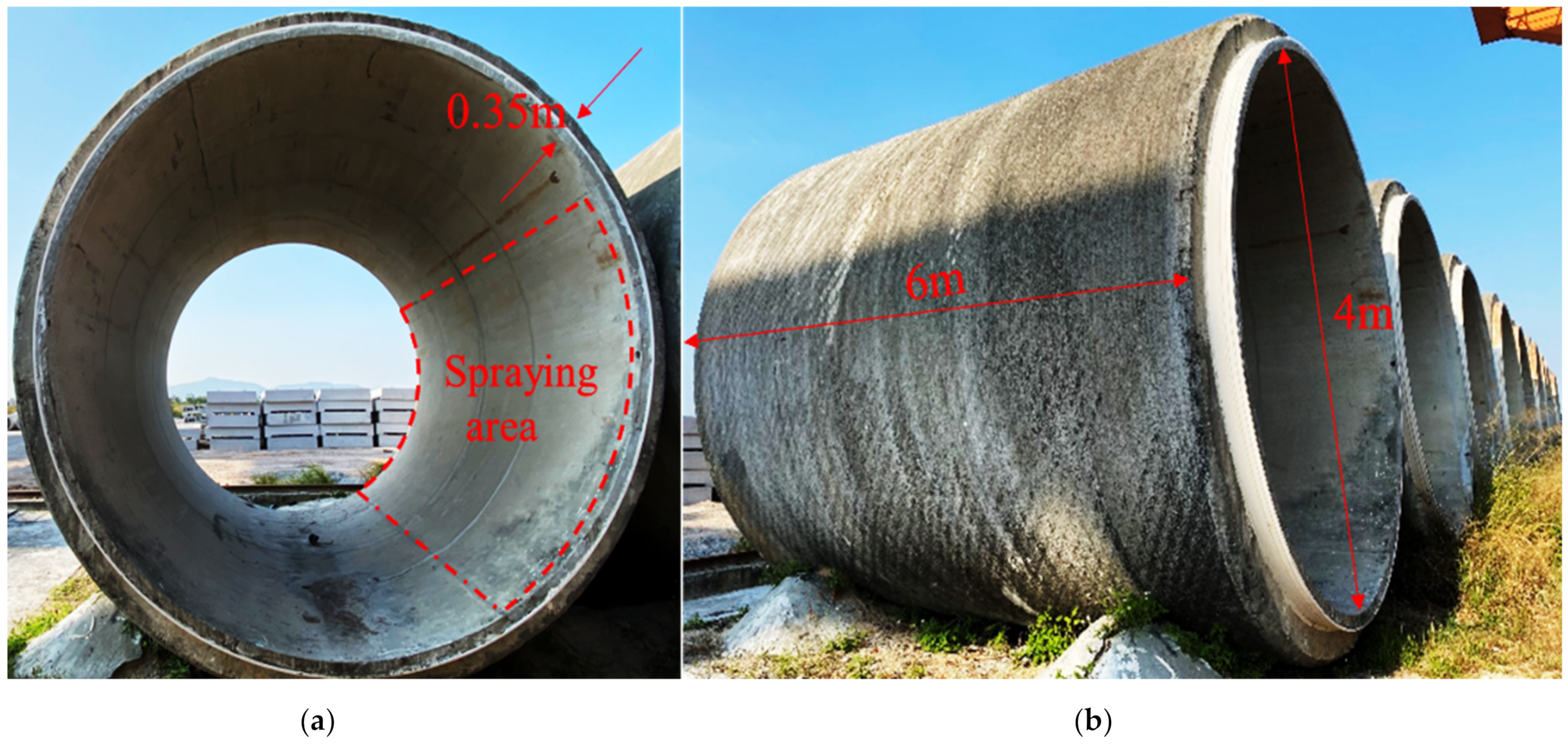
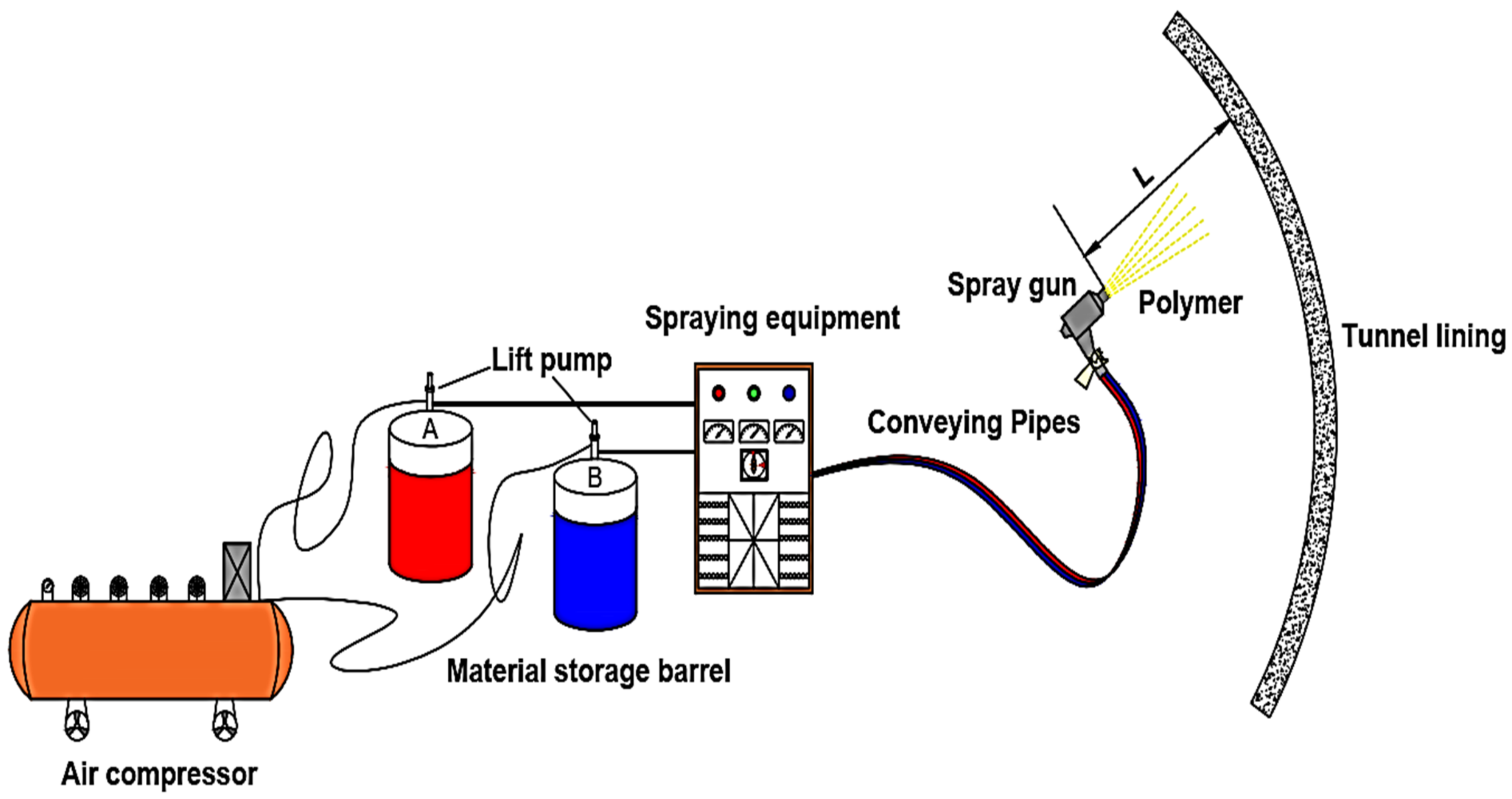
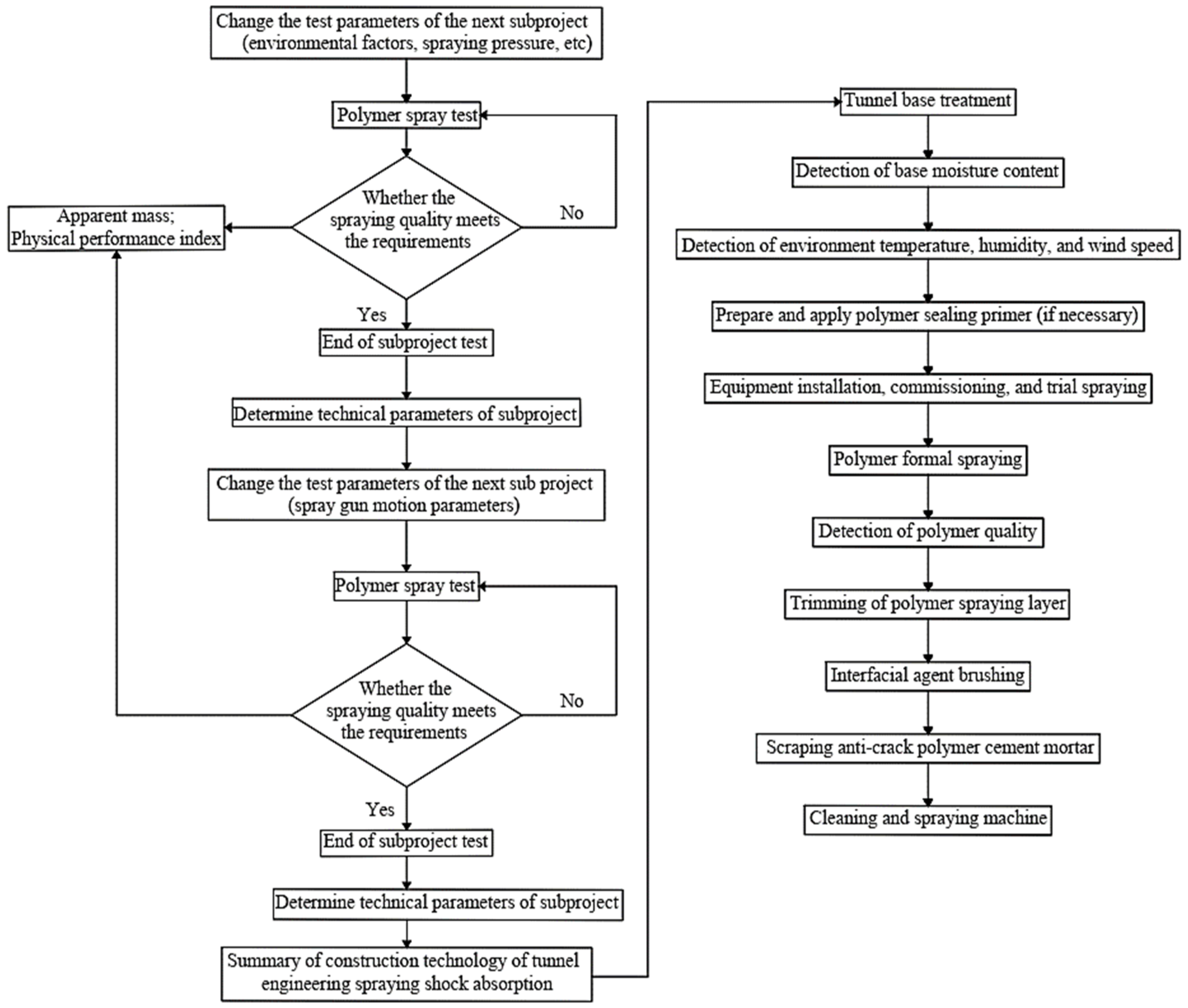
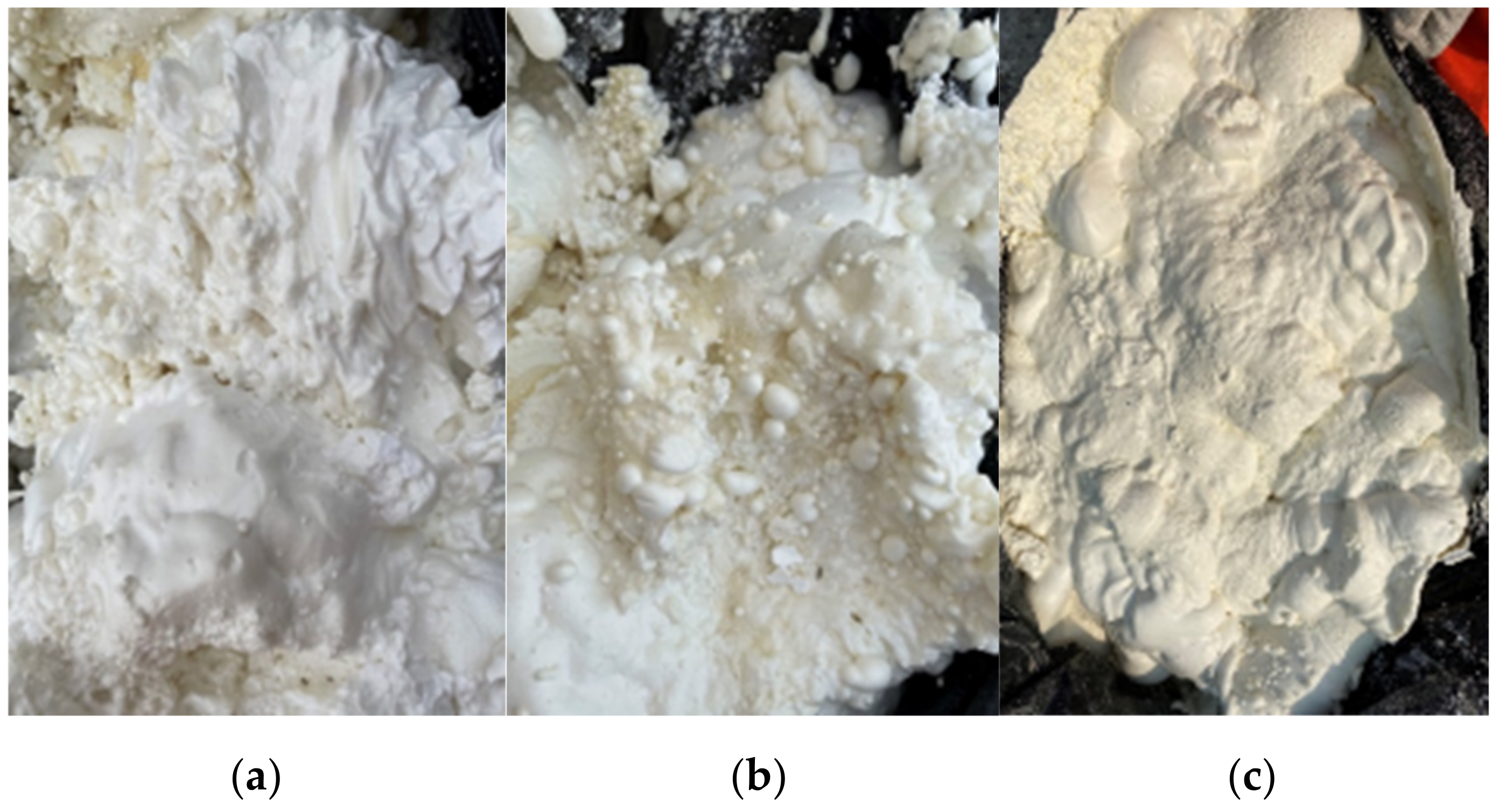

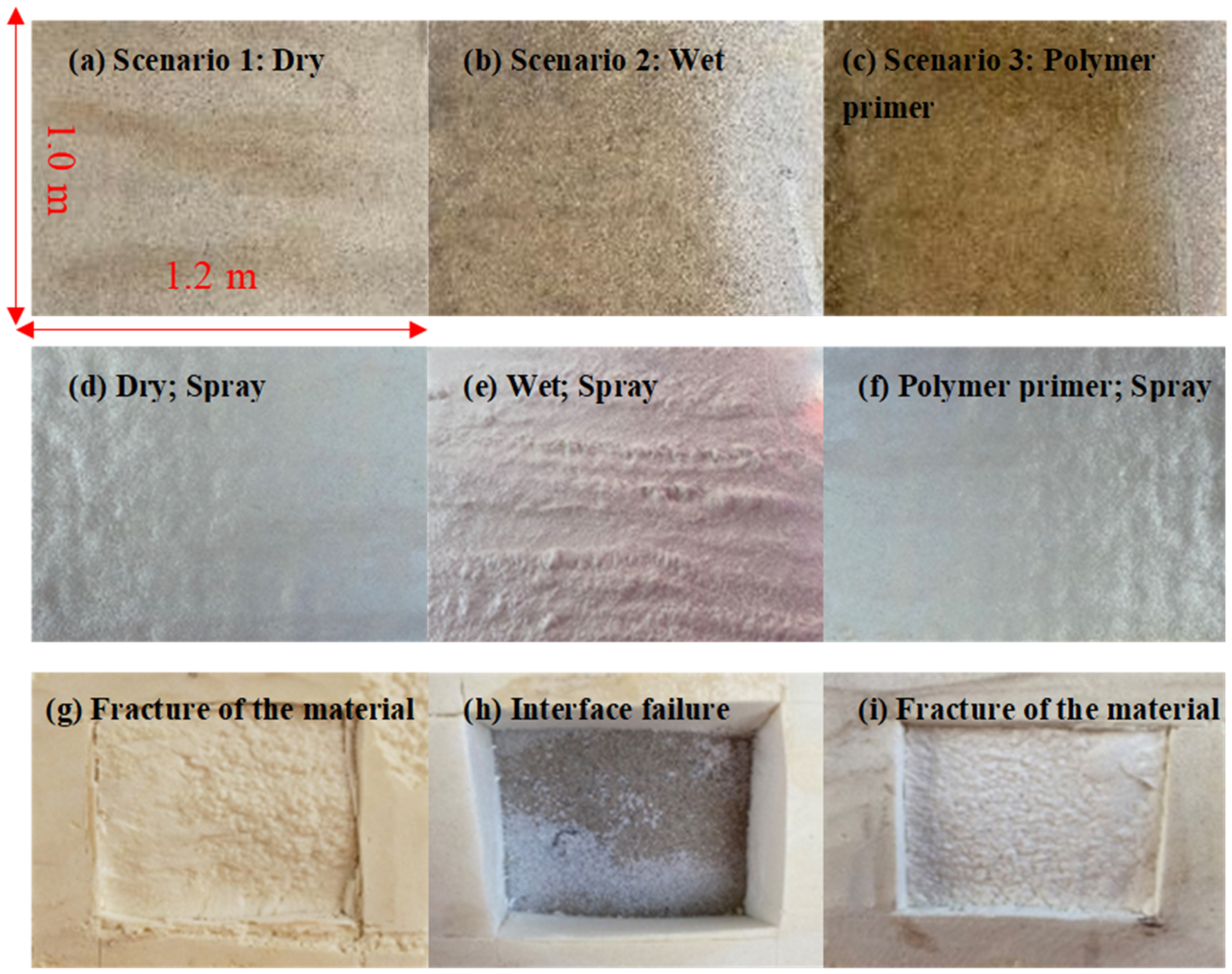


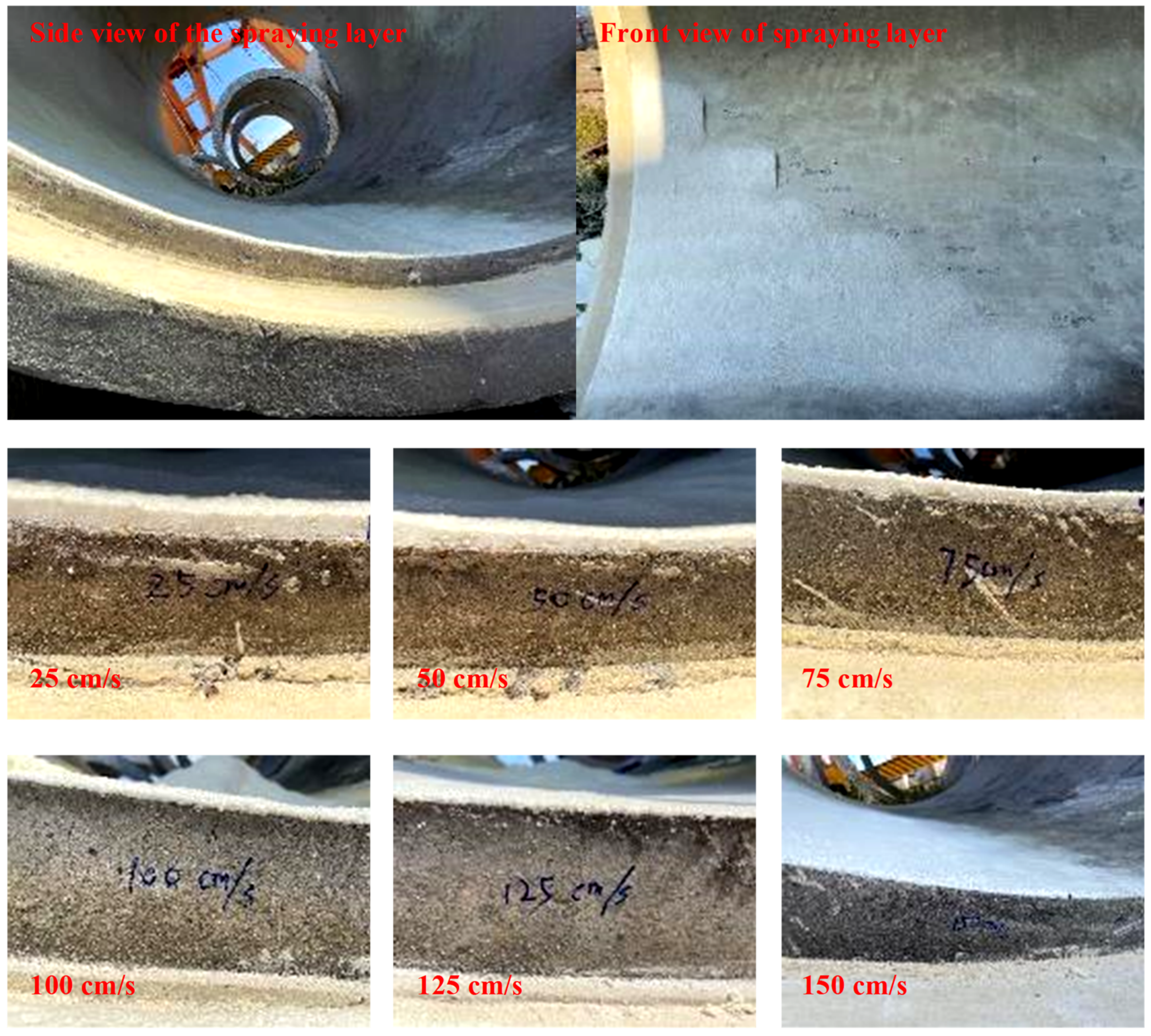
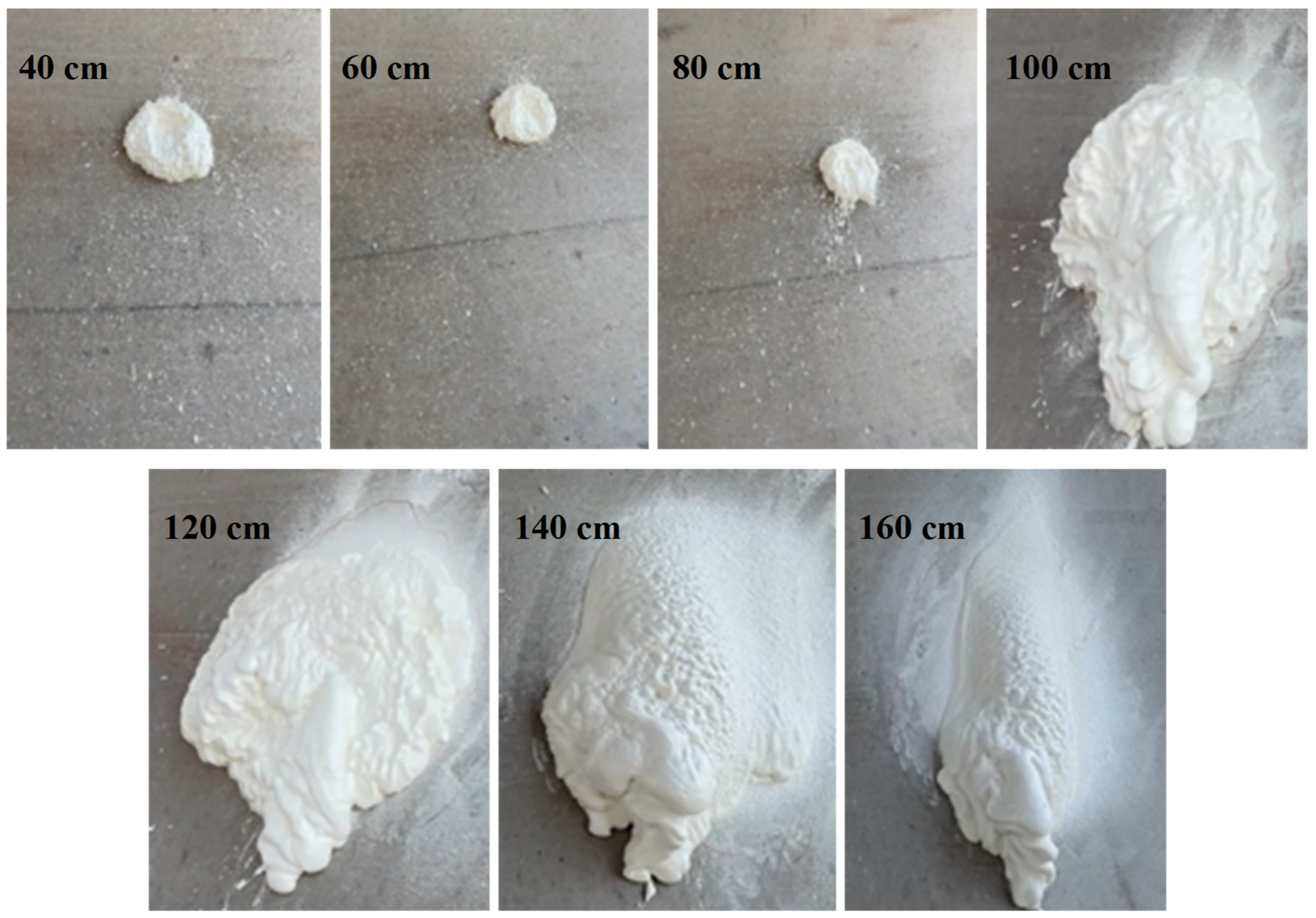
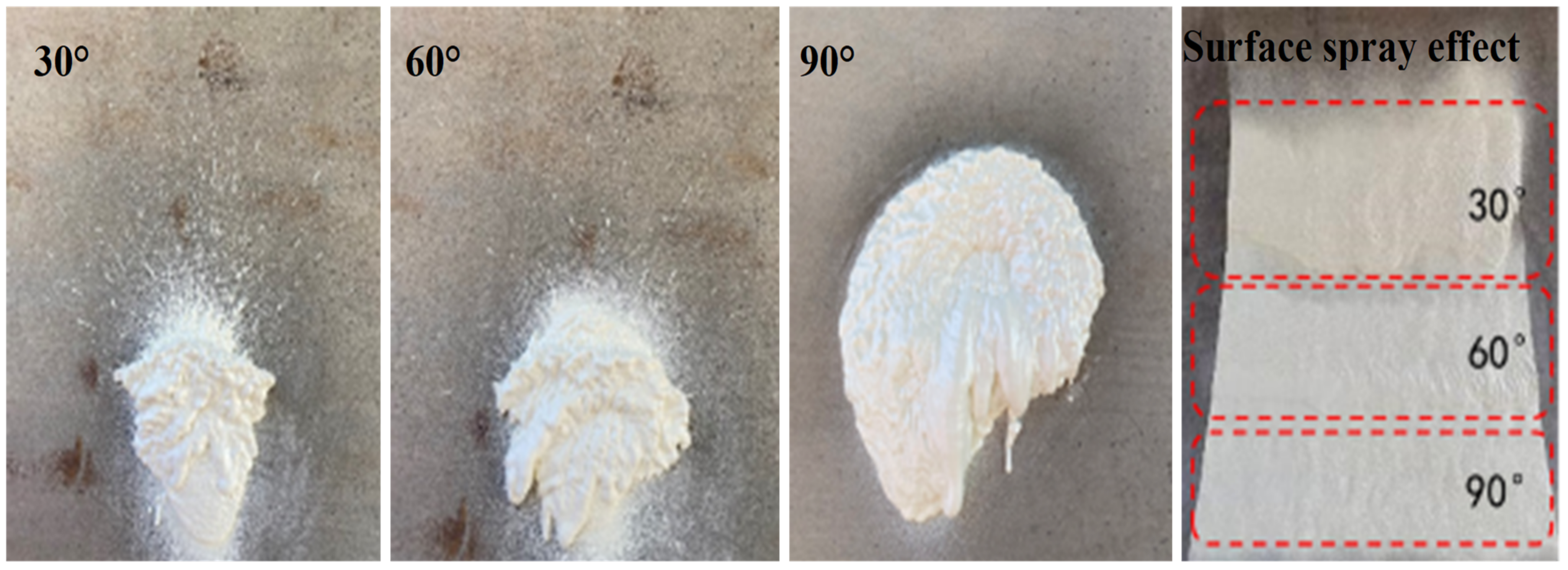
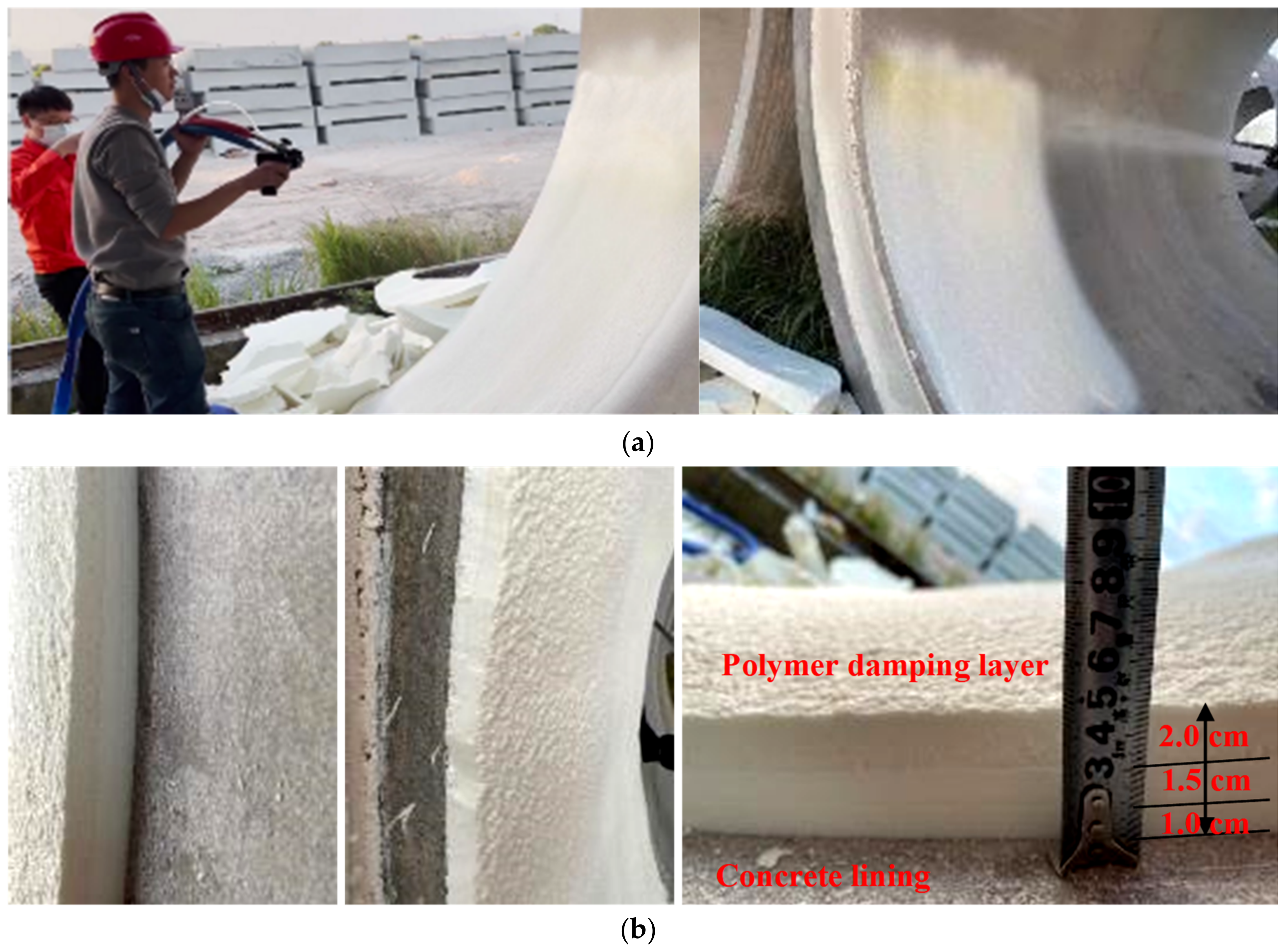
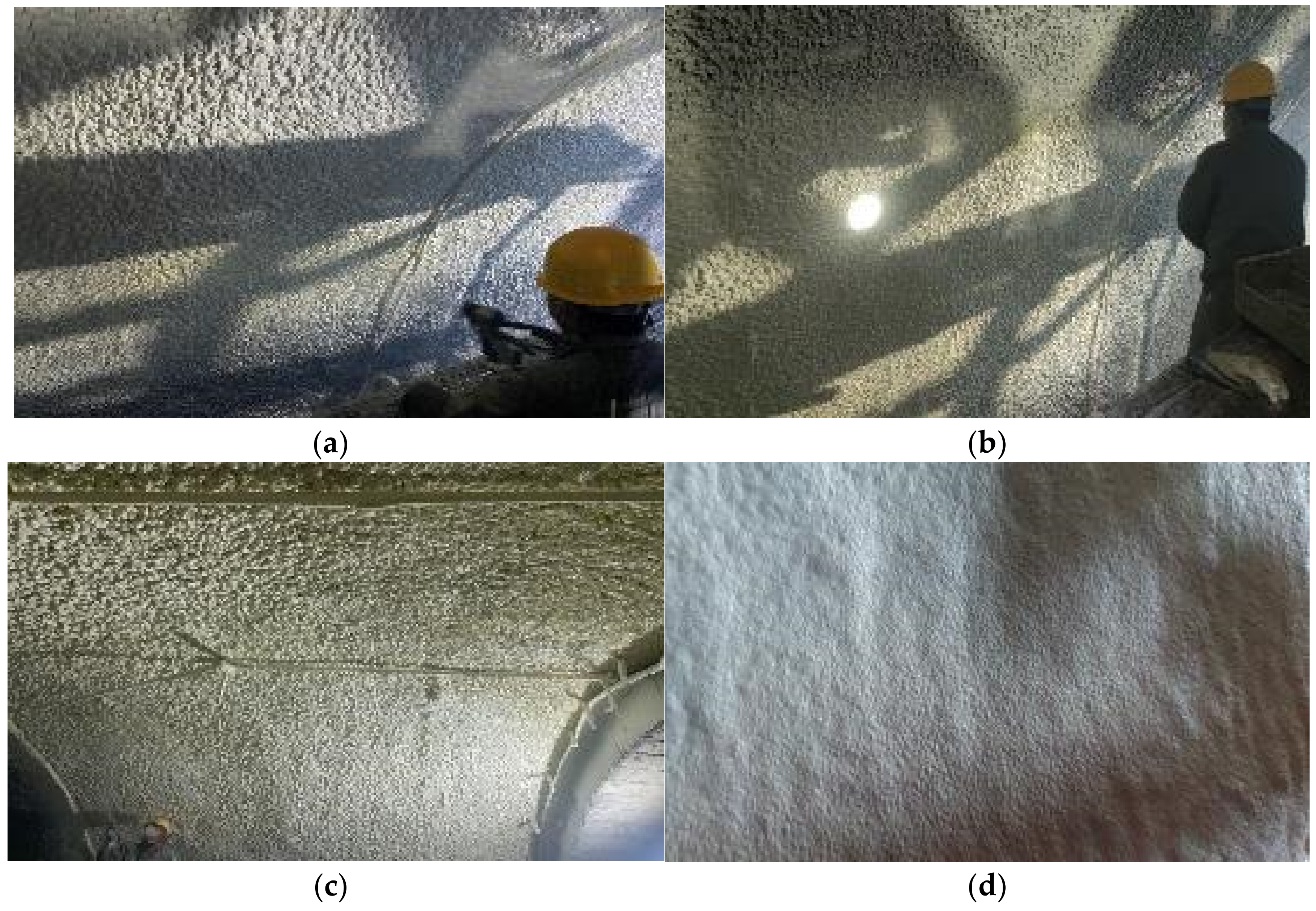
| Influence Factors | Test Parameter Selection | |||||||
|---|---|---|---|---|---|---|---|---|
| Material ratio | <1:1 | 1:1 | >1:1 | |||||
| Material temperature, °C | 25 | 35 | 45 | 55 | 65 | |||
| Environment and tunnel base temperature, °C | 10 | 25 | ||||||
| Humidity of tunnel base | 6% (<8%) | 12% (>8%) | 12% (>8%) + Polyurethane primer | |||||
| Wind speed, m/s | 3 | 7 | ||||||
| Spraying pressure, MPa | 4 | 6 | 8 | 10 | 12 | 14 | 16 | 18 |
| Spray gun speed, cm/s | 25 50 | 75 100 | 125 | 150 | ||||
| Spraying distance, cm | 40 60 80 100 120 140 160 | |||||||
| Spraying angle, ° | 30° 60° 90° | |||||||
| Tensile Adhesive Strength (kPa) | Damage Location | Sagging Situation | Splash Situation | Debonding Time (s) | |
|---|---|---|---|---|---|
| 25 | 165 | Polymer | Slight | Serious | 6 |
| 35 | 401 | Polymer | None | None | 5 |
| 45 | 418 | Polymer | None | None | 3 |
| 55 | 300 | Polymer | None | None | 2 |
| 65 | 195 | Base interface | Severe exotherm | None | 2 |
| Diffusion Radius (cm) | Atomization Effect | Sagging Situation | Splash Situation | |
|---|---|---|---|---|
| 4 | 6 | Very bad | Serious | None |
| 6 | 24 | Very bad | Slight | None |
| 8 | 28 | Poor | Slight | None |
| 10 | 32 | Good | None | None |
| 12 | 35 | Good | None | None |
| 14 | 40 | Better | None | Slight |
| 16 | 42 | Better | None | Serious |
| 18 | 45 | Better | None | Serious |
| Spray Coating Situation | Single Coating Thickness (cm) | Apparent Density (kg/m3) | |
|---|---|---|---|
| 25 | More uniform | 1.9–2.1 | 512 |
| 50 | More uniform | 1.1–1.3 | 498 |
| 75 | Uniform | 0.7–1.0 | 502 |
| 100 | Uniform | 0.6–0.8 | 494 |
| 125 | Uniform | 0.4–0.5 | 522 |
| 150 | Nonuniform | 0.2–0.3 | 510 |
| Diffusion Radius (cm) | Sagging Situation | Splash of Materials | Spray Coating Situation | |
|---|---|---|---|---|
| 40 | 35 | Slight | Serious | Uneven |
| 60 | 38 | Slight | Serious | Uneven |
| 80 | 40 | Slight | Slight | Uneven |
| 100 | 41 | None | Slight | More uniform |
| 120 | 36 | None | None | Uniform |
| 140 | 28 | None | None | Uneven |
| 160 | 26 | None | None | Uneven |
| Parameter | Value (Range) |
|---|---|
| (%) | <8 |
| (m/s) | <5 |
| (℃) | 10–35 |
| (℃) | 35–45 |
| 1:1 | |
| (MPa) | 10–12 |
| (cm/s) | Varying |
| (cm) | 100–120 |
| (°) | 90 |
| Indicator | During Spray | After Spray |
|---|---|---|
| Surface crusting | None | - |
| Bubble or hanging flow | None | - |
| Debonding time (s) | ≤30 | - |
| Strength development cycle (min) | ≤20 | - |
| Density (kg/m3) | - | 120 |
| Thermal conductivity at 23 ± 2 °C (W/(m∙k)) | - | ≤0.036 |
| Tensile adhesive strength to cement mortar (MPa) | - | ≥0.10 (the damage shall not be located at the bonding interface) |
| Permeability | - | Impermeable |
Publisher’s Note: MDPI stays neutral with regard to jurisdictional claims in published maps and institutional affiliations. |
© 2022 by the authors. Licensee MDPI, Basel, Switzerland. This article is an open access article distributed under the terms and conditions of the Creative Commons Attribution (CC BY) license (https://creativecommons.org/licenses/by/4.0/).
Share and Cite
Sun, B.; Guo, C.; Chen, Y.; Chu, X.; Ma, X. Study on Spraying Construction Method of a Non-Water Reacting Polymer Layer in the Tunnel. Materials 2022, 15, 4138. https://doi.org/10.3390/ma15124138
Sun B, Guo C, Chen Y, Chu X, Ma X. Study on Spraying Construction Method of a Non-Water Reacting Polymer Layer in the Tunnel. Materials. 2022; 15(12):4138. https://doi.org/10.3390/ma15124138
Chicago/Turabian StyleSun, Bo, Chengchao Guo, Yu Chen, Xuanxuan Chu, and Xue Ma. 2022. "Study on Spraying Construction Method of a Non-Water Reacting Polymer Layer in the Tunnel" Materials 15, no. 12: 4138. https://doi.org/10.3390/ma15124138
APA StyleSun, B., Guo, C., Chen, Y., Chu, X., & Ma, X. (2022). Study on Spraying Construction Method of a Non-Water Reacting Polymer Layer in the Tunnel. Materials, 15(12), 4138. https://doi.org/10.3390/ma15124138







